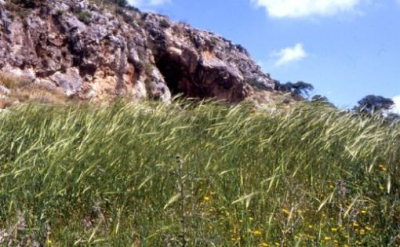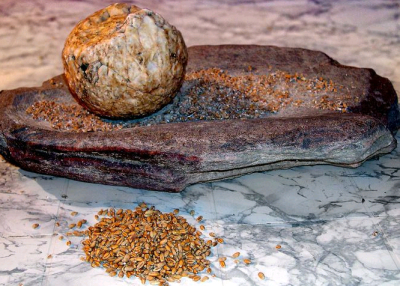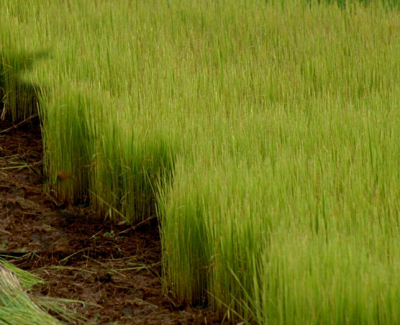
Neolithic Revolution: Where did agriculture come from?
 Mankind
has fed ourselves as hunter-gatherers for 99% of our time on
earth. Why did
we suddenly put down our spears and pick up the hoe?
Mankind
has fed ourselves as hunter-gatherers for 99% of our time on
earth. Why did
we suddenly put down our spears and pick up the hoe?
Archaeologists agree
that several factors coincided to make agriculture
possible around 8500 BC. Wild cereals were already part of the
diet of nomadic hunter-gatherers, but around 10,000 years ago climate
change increased the extent of these fields of native grain in the
Fertile Crescent. At about the same time, we began to develop
tools
and tricks necessary to take full advantage of the wild grains --- we
created sickles, baskets, and mortars and pestles; we figured out how
to roast grains so that they wouldn't sprout during  storage; and we
developed underground
storage pits.
Suddenly, a family could
gather enough seeds to feed itself for a year during the three week
ripening season of the wild wheat.
storage; and we
developed underground
storage pits.
Suddenly, a family could
gather enough seeds to feed itself for a year during the three week
ripening season of the wild wheat.
Now, as someone who
spends months during the summer carefully tending
my crops, I was a bit stumped when I read that last fact. If I
could just go out and pick wild swiss chard, okra, and tomatoes for
three weeks once a year and not have to plant and weed all season, I
think I would choose the former occupation. Why did these early
wheat-eaters
turn into farmers?
The switch from
gathering this abundant wild wheat to growing it seems
to come down to one factor --- overpopulation. At the same time
that wild wheat was expanding in the Fertile Crescent, large wild game
was becoming much less numerous, either because of climate change,
because we became better hunters, because our numbers exploded, or some
combination of these three factors. Whatever the reason, hunting
was no longer really working for us, so wheat became more and more
important in our diets.

It seemed sensible to
settle down near the important wheat fields, and
this change in turn dismantled the factors that had previously kept our
population in check. As nomads, our women had been limited to
bearing children about four years apart in age since the first child
had to be old enough to walk by itself before baby number two could
come along --- Mom could only carry one kid at a time during frequent
moves and I guess Dad wasn't the nurturing type. But we no longer
had this restriction in our new, settled lifestyle, so our reproductive
rate doubled, with women producing on average one child every two years.
When previously ample
wheat fields suddenly became too bit puny to feed our burgeoning
numbers, agriculture was the clear solution. By clearing
new ground outside the natural wheat fields, we were able to plant wild
wheat seeds and reap harvests from a larger area. Agriculture was
born.
This post is part of our History of Agriculture lunchtime series.
Read all of the entries:
|
Want more in-depth information? Browse through our books.
Or explore more posts by date or by subject.
About us: Anna Hess and Mark Hamilton spent over a decade living self-sufficiently in the mountains of Virginia before moving north to start over from scratch in the foothills of Ohio. They've experimented with permaculture, no-till gardening, trailersteading, home-based microbusinesses and much more, writing about their adventures in both blogs and books.
Want to be notified when new comments are posted on this page? Click on the RSS button after you add a comment to subscribe to the comment feed, or simply check the box beside "email replies to me" while writing your comment.

Some historians / anthropologists think men had to have their hands free to carry weapons which leaves child-toting to the women. Others think that's silly since there were plenty of adolescents to carry children not yet able to travel on their own.
But I think the bigger issue has to do with mortality rates. I don't know the sources from that period, but when the author talks about the birth rates, is he counting pregnancies or is he counting children who survive childhood? In the early-modern period, a woman who was nursing her own children (which is most women except the very, very wealthy who used wet nurses and got pregnant more) could expect to get pregnant 6-7 times on average, and, on average, 3-4 of those children would survive childhood. It's grim, but it's population control. Besides the mortality rate, there's also the issue of how long pre-modern women nursed. It's my understanding that early-modern European women weaned their children somewhere between the ages of 1 and 2, but certainly in some cultures it's longer. That's going to reduce the birth rate also, if children aren't being weaned until they're toddlers.
Just some more thoughts.
Heather
Have you read J. M. Auel's Earth's Children series? They're novels and do not purport to scientifically accurate, but she did a lot of research for those books and I think it gives an interesting and plausible look into life in the stone age.
Yes, that's them.
Personally I like the the later parts (The Valley of Horses, The Mammoth Hunters, The Plains of Passage and The Shelters of Stone) better than the first, but YMMV.
According to Wikipedia;
Quite interesting I found them.
Some years ago I came across a mortality graph by age through the centuries. What struck me most where the two bands of high mortality that could be seen; The first was children dying young (I've come across figures of 300 deaths in a 1000 live births in the age group below five in the ages before modern medicine). The second was women dying in childbirth in their early twenties. What surprised me was how only relatively recently those figures have changed.
A now extict plant called silphium was known as a contraceptive since ancient times. It has been found depicted on 2500 year old coins. Given the large amount of folk knowledge concerning medicinal use of plants, there are probably many more.
I suspect there were also strong regulatory effects from the environment in the case of hunter/gatherers. If food is scarce, aren't the old and young usually the first to die? I guess that this makes sense in evolutionary terms because neither group is in the reproductive age. Furthermore one would expect the chances of miscarriage to increase in times of food shortages or nutritional deficiencies.
My understanding is that even though farmers clearly knew the same population control measures as their hunter-gatherer neighbors and ancestors, they didn't practice them (or at least not much). According to the books I read, kids were a boon in a farmer society because you could set them to work in the fields from a pretty early age. Reading between the lines, I wonder whether that type of new farming society gave rise to the religions that that forbid birth control?
Stay tuned for Friday's post to answer your last paragraph....